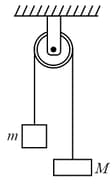MEDIUM
Agniveer Vayu
IMPORTANT
Earn 100
A uniform disc of radius R is put over another uniform disc of radius 2R of same thickness and density. The peripheries of the two discs touch each other. The position of their centre of mass is
(a)At from the centre of the bigger disc towards the centre of the smaller disc
(b)At from the centre of the bigger disc towards the centre of the smaller disc
(c)At from the centre of the bigger disc towards the centre of the smaller disc
(d)At from the centre of the smaller disc
100% studentsanswered this correctly

Important Questions on Systems of Particles and Rotational Motion
EASY
Agniveer Vayu
IMPORTANT
The centre of mass of a system of two particles divides the distance
EASY
Agniveer Vayu
IMPORTANT
Consider a two particle system with particles having masses and . If the first particle is pushed towards the centre of mass through a distance , by what distance should the second particle be moved, so as to keep the centre of mass at the same position?
EASY
Agniveer Vayu
IMPORTANT
An isolated particle of mass is moving in a horizontal plane (), along the -axis, at a certain height above the ground. It suddenly explodes into two fragments of masses and . An instant later, the smaller fragment is at . The larger fragment at the instant is at:
MEDIUM
Agniveer Vayu
IMPORTANT
Two masses and are joined by a light string passing over a smooth light pulley. The centre of mass of the system moves with an acceleration -

EASY
Agniveer Vayu
IMPORTANT
If the system consists of two identical particles. One particle is at rest and the other particle has an acceleration . The centre of mass of the system has an acceleration of
EASY
Agniveer Vayu
IMPORTANT
Assertion: The centre of mass of an electron and proton, when they were released from rest, moves faster towards proton.
Reason: Proton is heavier than electron.
EASY
Agniveer Vayu
IMPORTANT
Two identical particles move towards each other with velocity and respectively. The velocity of centre of mass is
EASY
Agniveer Vayu
IMPORTANT
A cannon shell fired breaks into two equal parts at its highest point. One part retraces the path to the cannon with kinetic energy and kinetic energy of the second part is , relation between and is
